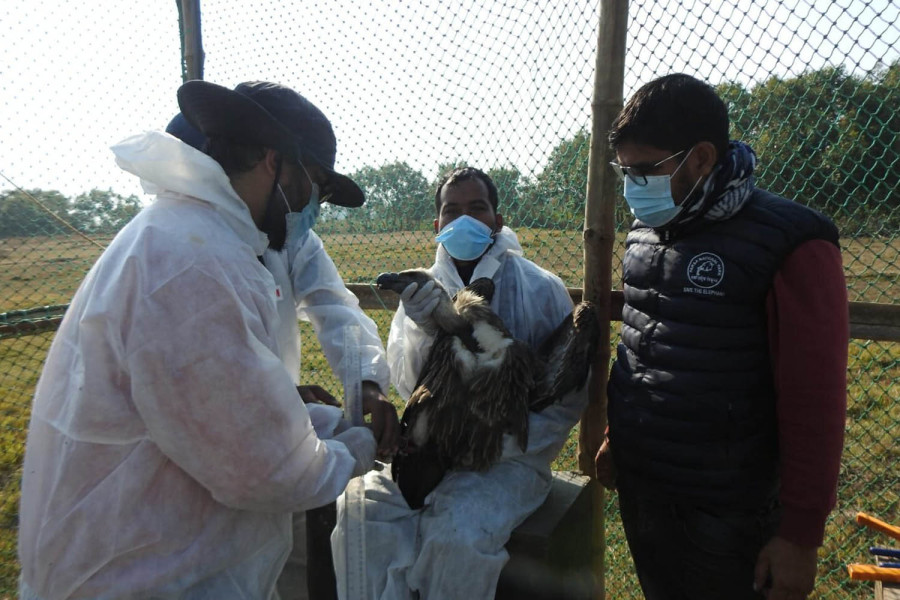Sudurpaschim Province
Researchers use GPS tags to track vultures at Shuklaphanta National Park
Study aims to find out movement patterns and habitat preferences of vultures in farwest Nepal.
Bhawani Bhatta
How far can a vulture soar in its relentless quest for food? What secrets does its habitat hold? These important questions are being explored in Shuklaphanta National Park, located in the plains of farwestern Nepal. Researchers have fitted these birds with Global Positioning System (GPS) tags to gain insight into their foraging habits and movement patterns. This technology allows scientists to track the vultures’ daily journeys, revealing their feeding habits and how far they travel in search of food.
Over the past year, 14 vultures have been tagged to monitor their nesting habits and overall health. The park has tagged ten white-rumped vultures and four slender-billed vultures with technical support from Bird Conservation Nepal. Unfortunately, two slender-billed vultures have died, and two others—one white-rumped and one slender-billed—have lost their signal, according to Manoj Air, conservation officer at Shuklaphanta National Park.
“Two or three vultures have been tracked travelling from the national park to locations such as Amargadhi in Dadeldhura, Pancheshwar in Bajhang, and Lohaghat across the border in India. They are making regular trips,” said Air.
According to him, GPS tags were fitted to vultures nesting in the Bhatpuri and Tarapur areas of the park in November 2023. These tags will assist researchers in studying their population, movements, habitats, and overall health.
Some vultures have been tracked flying as far as Lakhimpur, Khiri, and Pilibhit in the Indian state of Uttar Pradesh before returning within two to three days. He also said that vultures from the park have reached as far as Nanak Sagar in Uttarakhand and Dudhwa National Park in Uttar Pradesh.
“A vulture is currently travelling approximately 100 kilometres daily,” said Hirulal Dagoura, a technical officer at Bird Conservation Nepal. “It seems to be following the banks of the Mahakali river, reaching as far as Pancheshwar and Mailali in Bajhang, and crossing into India to areas like Champawat and Lohaghat.”
He said the vultures tend to stay in the area for a few days before returning.
According to Dagoura, vultures have also been observed foraging in the grasslands of the park’s eastern regions, including Bhatpuri and Tarapur. Some have even ventured as far as Dhangadhi.
Last year’s census identified 120 nests in Shuklaphanta, primarily in Tarapur and Jonapur, where vultures have been tagged. Monitoring of the tagged vultures is ongoing, though two remain unaccounted for. Their signals were lost after heavy rainfall in mid-July, and no updates have been received. Dagoura said that the last known locations of the two missing vultures were within Indian territory. The severe rainfall in the region hindered efforts to re-establish contact with them.
How vultures are tagged
Vultures are tagged by placing carrion inside a bamboo trap with doors on either side and netting. One door is closed when a vulture enters the trap to feed on the carrion. Technicians then safely capture the vulture, attach a GPS tag, and release it. This process aids in identifying their habitats and movement patterns.
“We plan to tag more vultures this year,” said Dagoura, adding they will proceed once the Department of National Parks and Wildlife Conservation grants permission.
Established as a wildlife reserve in 1976 and declared a national park in 2017, Shuklaphanta is located in the southwestern corner of Nepal in the Sudurpaschim Province.




 22.65°C Kathmandu
22.65°C Kathmandu















